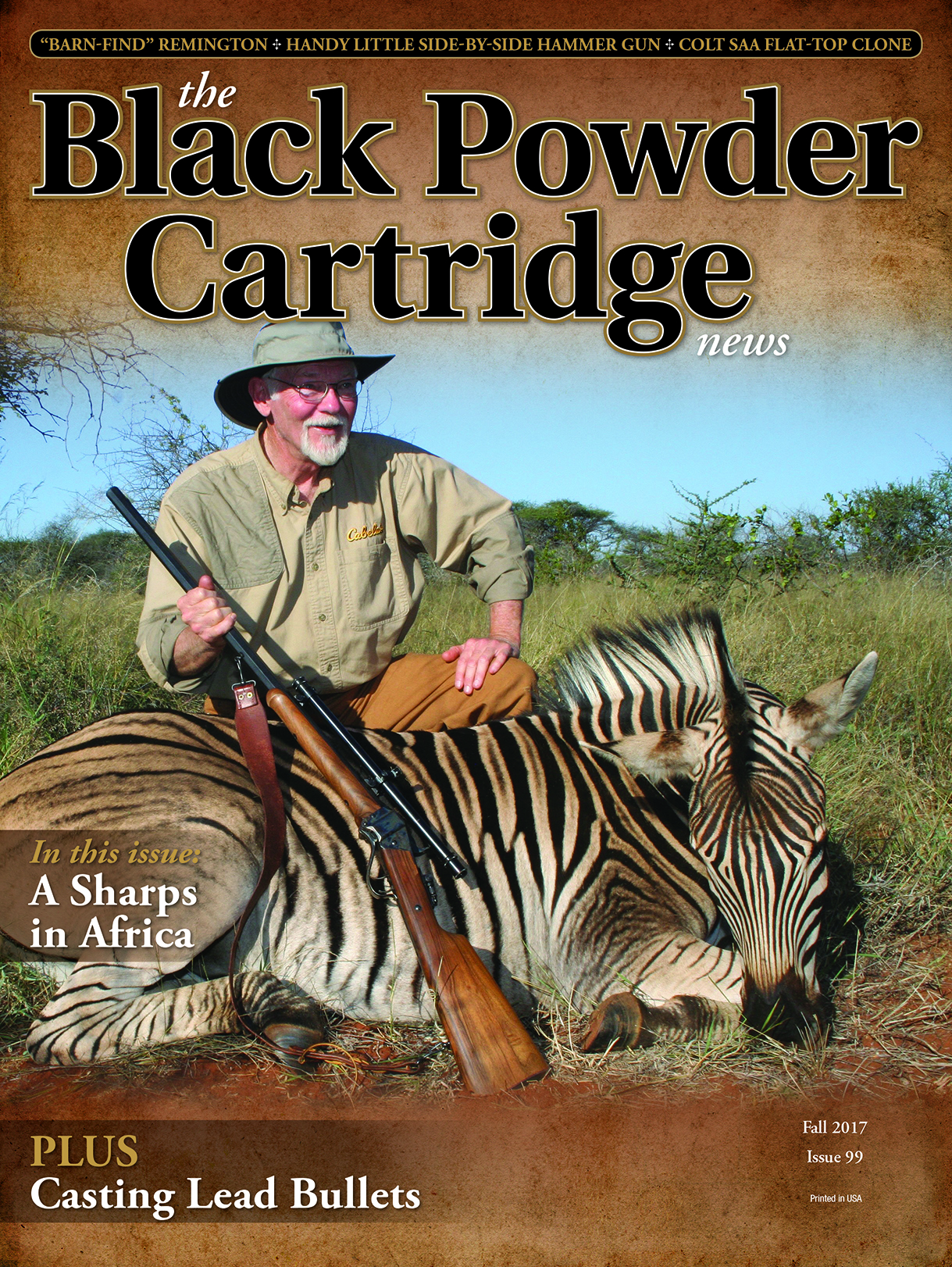The Wyoming Schuetzen Union's Center Shot
The National Rifle Club
column By: Leo Remiger | October, 17
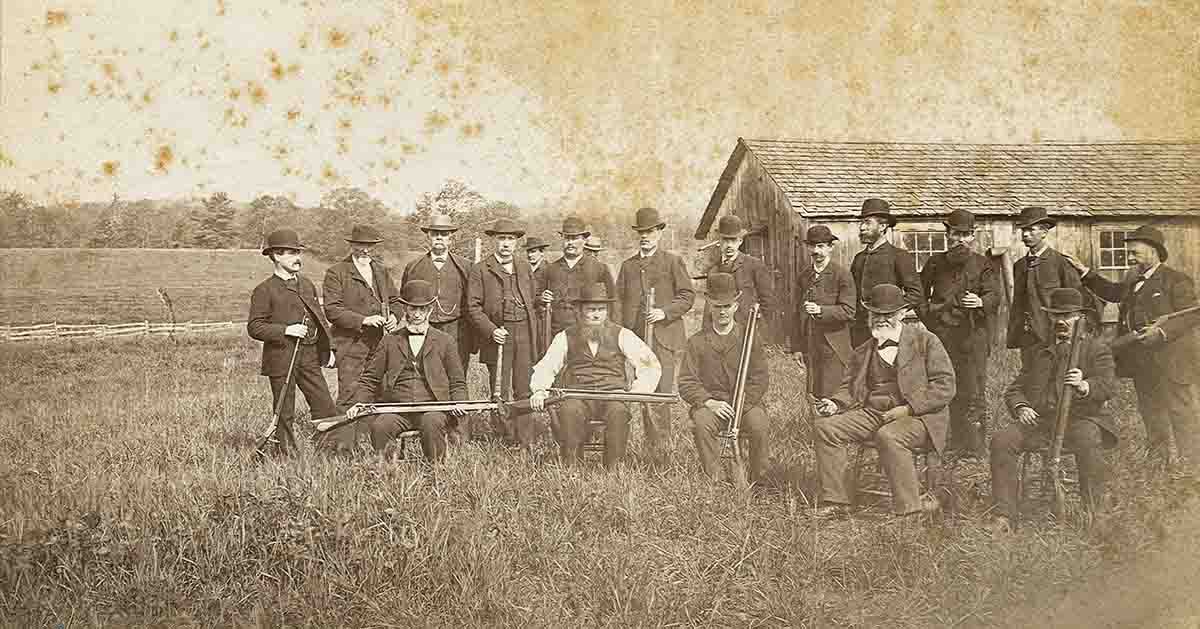
The first meeting of the National Rifle Club was held at Waltham, Massachusetts, in 1855. The meeting lasted two days and three prizes were shot for by 23 members. The rifles used in the match were heavy-barreled
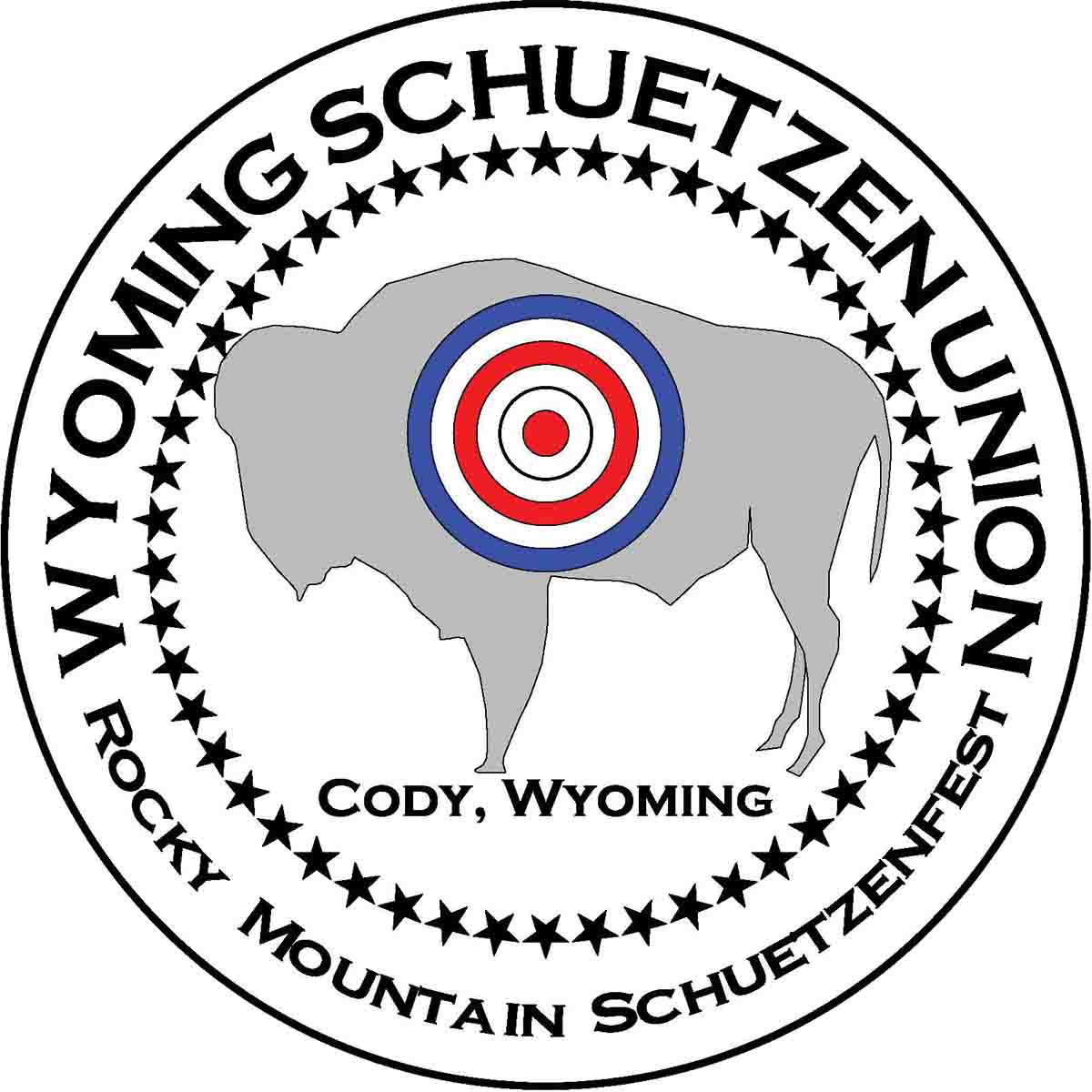
Some of the members thought that if the weight of the rifles was reduced, and shot from the shoulder versus machine rest, increased attendance at the meetings would be obtained. The experiment proved unsuccessful. The heavier rifles – being heavily handicapped – gave them no chance of success. The allowable weight of the rifles was reduced to 15 pounds, which became the standard weight. The rifles varied in caliber, and at one time it was unusual to find one under .40 caliber, some were as large as .60 caliber.1
William V. Lowe sent the editor of Forest and Stream an invitation to riflemen to attend the National Rifle Club’s spring meeting. The invitation was published on April 15, 1886, and was printed as follows:
NATIONAL RIFLE CLUB
Editor Forest and Stream;
On the last Wednesday in May, at Vernon, Vt., will be held the spring meeting of the National Rifle Club, one of the oldest, if not the oldest club of its kind in existence in this country, and I think in the world. This club shoots exclusively muzzleloaders, hair triggers, telescopic sights, at 40 rods, string measure; 10 per cent, odds are allowed to parties shooting from the shoulder with only a muzzle rest, and an extra 10 per cent to those who also use open sights, i.e. other than telescopic or magnifying. It is hoped that the advocates of the breechloader will be induced to attend and compete.
Several of Boston’s crack rest-shooters have signified their intentions to be present and shoot, Frye, Rabbeth, Hinman, Gould, Maynard, and Frank Wesson, of Worcester. I give you a most cordial invitation to be present and shoot if you feel disposed to do so, and would be glad if you could induce other shooters to attend. Thirty shots will be fired, three strings of 10 shots each, one string Wednesday about 2 P.M., two strings Thursday, one at about 10 A.M., the other about 2 P.M. Vernon is reached by New London Northern & Connecticut River road, a short distance from Greenfield, Mass., and Brattleboro and Bellows Falls, Vt.
– William V. Lowe,
Fitchburg, Mass.2
Forest and Stream received correspondence and printed one or two letters concerning the upcoming match. The National Rifle Club also provided additional information that appeared in Forest and Stream (May 6, 1886) as reprinted below:
NATIONAL RIFLE CLUB
The spring meeting of the club will be held at Vernon, Vt., May 26 and 27. A general invitation is extended to all interested in rifle shooting. Any one can become a member and entitled to all the privileges of the club by paying the $5 entrance fee to the match for prizes. The standard weight for rifle barrels being 15 lbs., all over must give the following odds; From 15-20 lbs,. ¼ inch to the pound for every 10 shots. From 20 to 30 lbs., 3⁄16 inch to the pound for every 10 shots. From 30 to 40 lbs., 1⁄16 inch to the pound for every 10 shots. Ten per cent will be allowed to parties shooting from shoulder. Ten per cent will be allowed for rifles under 10 lbs. and globe and peep sights. The first string will be called at 3 o’clock P.M., Wednesday; second string 10 A.M., Thursday; third string 2 P.M. Thursday. A silver medal will be given by Mr. Hiram W. Smith for the best 30 birds [?]. Distance 40 rods, time rules.
– John Williamson, President
N.S. Brockway, Secretary (Bellows Falls, Vt.).3
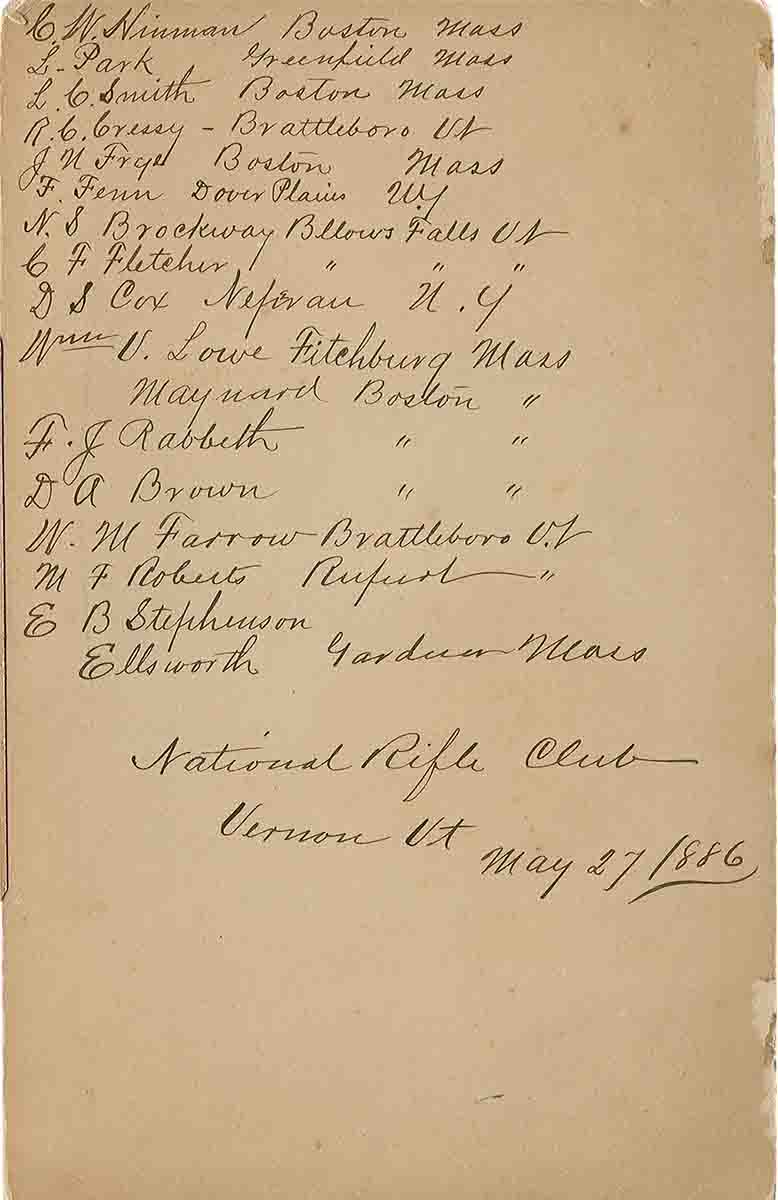
Names on Back of Cabinet Card
(Left to Right)
C.W. Hinman, L. Park, L.C. Smith, R.G. Cressy, J.N. Frye, F. Fenn, N.S. Brockway, C.F. Fletcher, D.S. Cox, William V. Lowe, William Maynard, F.J. Rabbeth, D.A. Brown, W.M. Farrow, M.F. Roberts, E.B. Stephenson, Ellsworth
Muzzle-Loading Cap Lock Rifle
(Front Row – Left to Right)
Hiram W. Smith, Norman S. Brockway, David H. Cox, D.A. Brown, B. Stephenson
(Back Row – Left to Right)
C.W. Hinman, D. Park, R.C. Cressy, J.N. Frye, Frank I. Fenn, C.F. Fletcher, William V. Lowe, William Maynard, F.J. Rabbeth, W. Milton Farrow, Milton F. Roberts, George F. Ellsworth
The photo has been reproduced in several publications. Ned H. Roberts, in his book, The Muzzle-Loading Cap Lock Rifle, mentioned A.C. Gould had taken the photograph.4 I began to look through The Rifle in the hopes of finding information that would detail Myron F. Roberts’ part in the match. The match was covered in detail in The Rifle (June 1886), and is reprinted here:
THE NATIONAL RIFLE
CLUB MEETING
The annual spring meeting of the National Rifle Club was held at Vernon, Vt., on May 26 and 27. This meeting may be said to be one of the most interesting ones held, on account of the acceptance of the invitation extended by the shooters of the heavy muzzle-loading rifles with telescopic sight, to the riflemen using the breech-loading rifle allowed under the rules of the National Rifle Association, to participate in the tournament. The meeting was an undoubted success, and is likely to be followed by other successful ones, in which the hitherto exclusive patrons of the different styles of rifle-shooting will fraternize, and increased interest, be manifested in these friendly contests. It was evident that curiosity tempted the shooters of the breech-loaders to visit this meeting more than the hope of vanquishing their rivals, which will account for a number of these riflemen being present without a rifle. The location of the meeting is one of the most charming resorts in New England, an excellent hotel, where every comfort can be procured and within a minute’s walk of the range.
Every courtesy was extended to the visitors; rests for shooting the breech-loading rifles from were constructed to suit the riflemen, and when the question of allowance made to the light rifles without telescopic sights was raised, it was speedily settled by allowing what was asked for. In addition to the courtesies extended to the visitors by the National Rifle Club was the warm greeting by the members of the Brattleboro Rifle Club, who were present during the meeting, and at its conclusion welcomed the visitors to their own range, where a friendly shoot was indulged in.
The terms of the matches of the National Rifle Club were as follows: One string of ten shots to be fired at the call on May 26, and two strings of ten shots each on May 27. Distance, 40 rods. String measurement. Entrance money divided, after deducting expenses of meeting, into three parts; one part for each match, and each amount sub-divided into fifty, thirty, and twenty per cent, for prizes. Standard weight for barrels of rifles using telescopic sights being fifteen pounds. For rifles shot from the shoulder, without a machine rest and without a telescope sight, an allowance of ten per-cent was made for the former, and the same for the latter. The shooters of the breech-loading rifles considering this allowance insufficient and an additional three inches was allowed for rifles under ten pounds in weight.
The first match was called at 4:20 P.M. on May 26, and the second and third on the following morning at 9:30 and 11:25. Five minutes for each shot was allowed on the first day, and eight minutes on the second day. The weather conditions were unfavorable on both days, an erratic wind blowing; but on the second day the wind was steadier than during the preceding day.
Following is a list of entries:
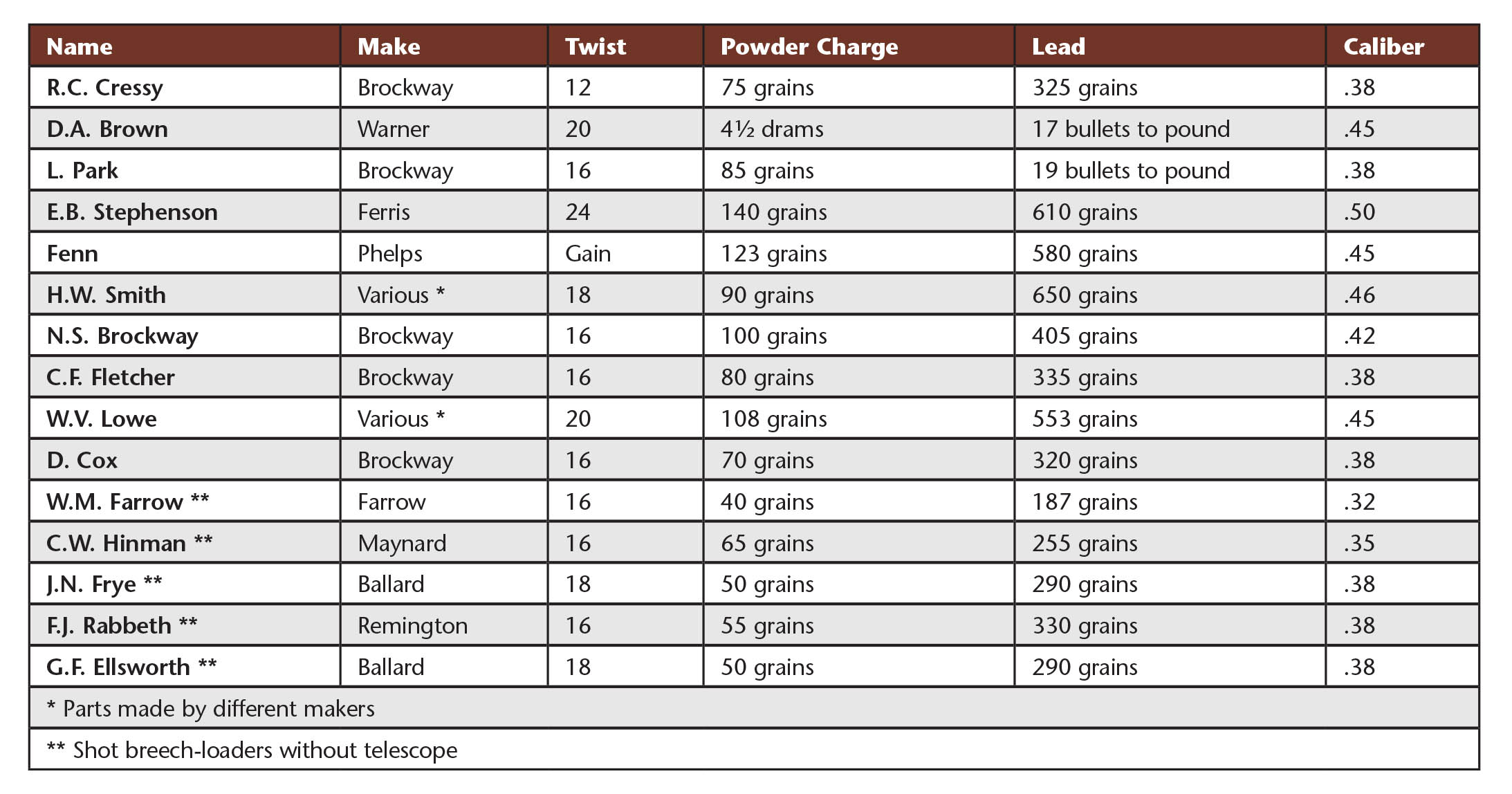
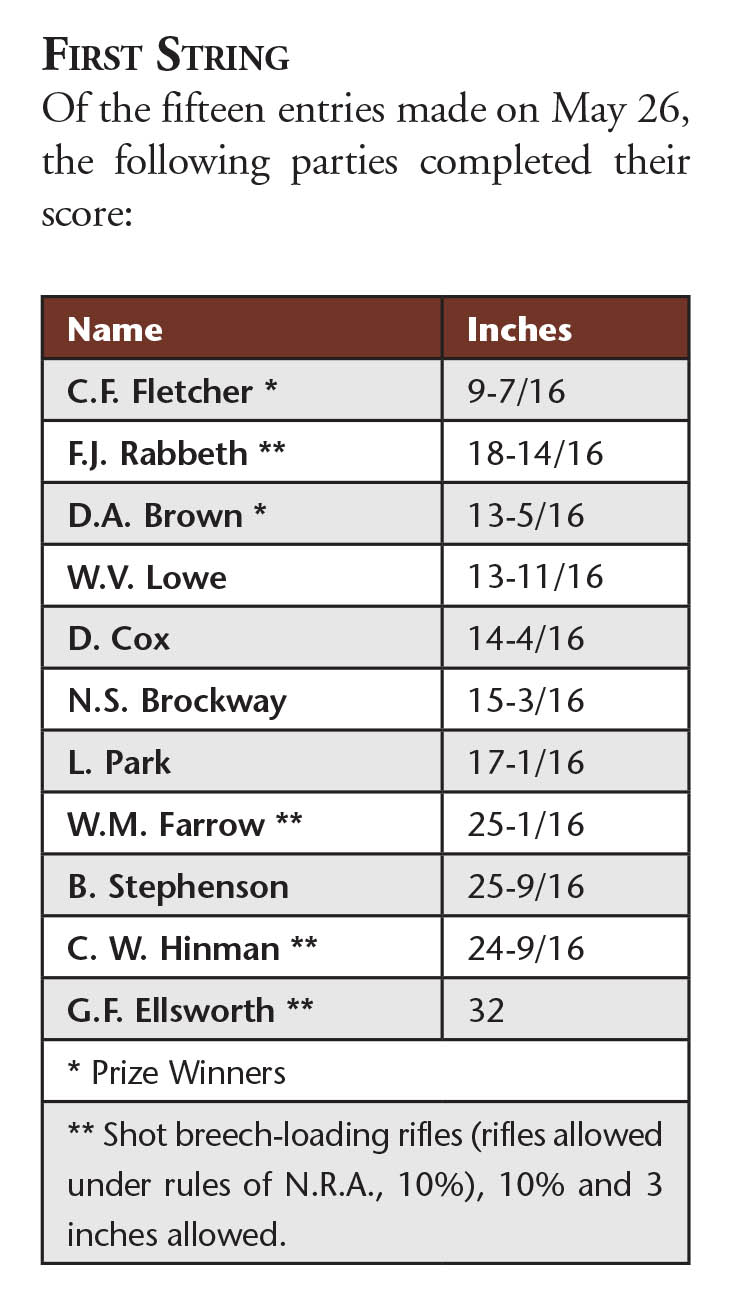
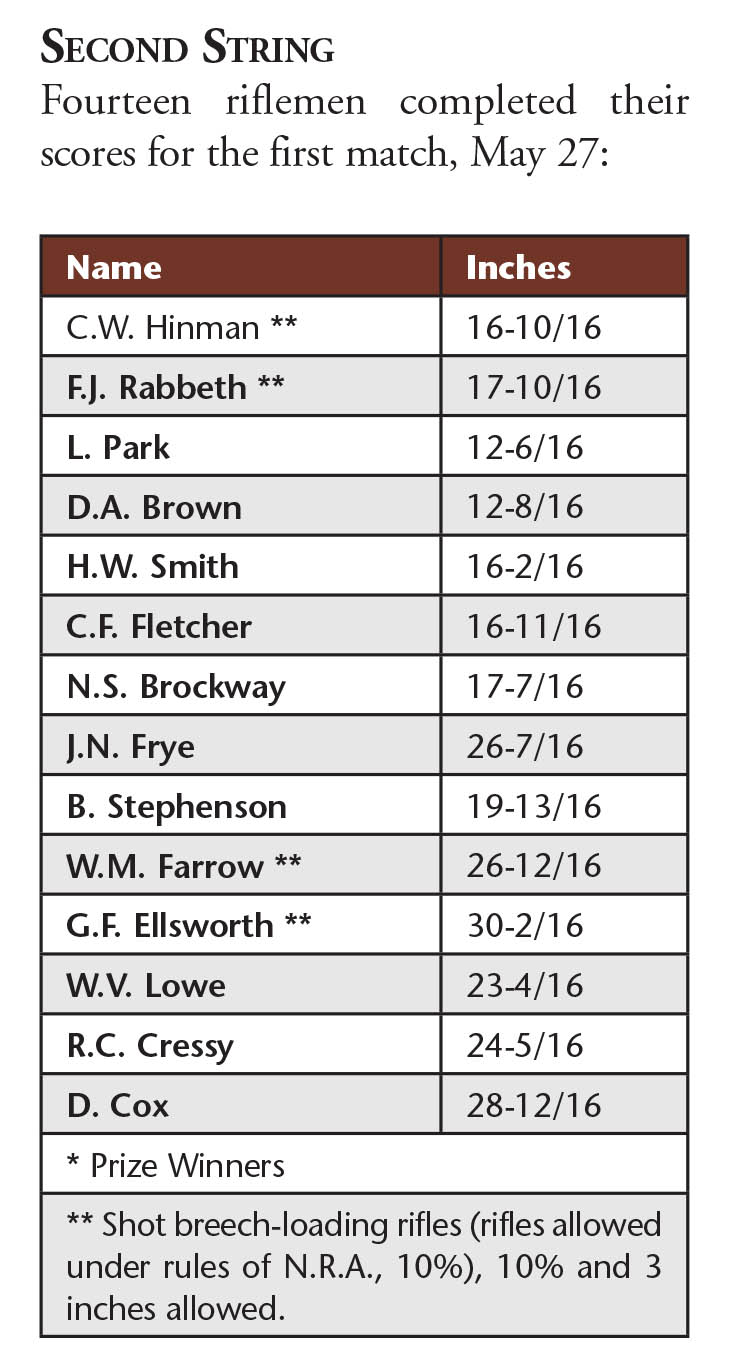
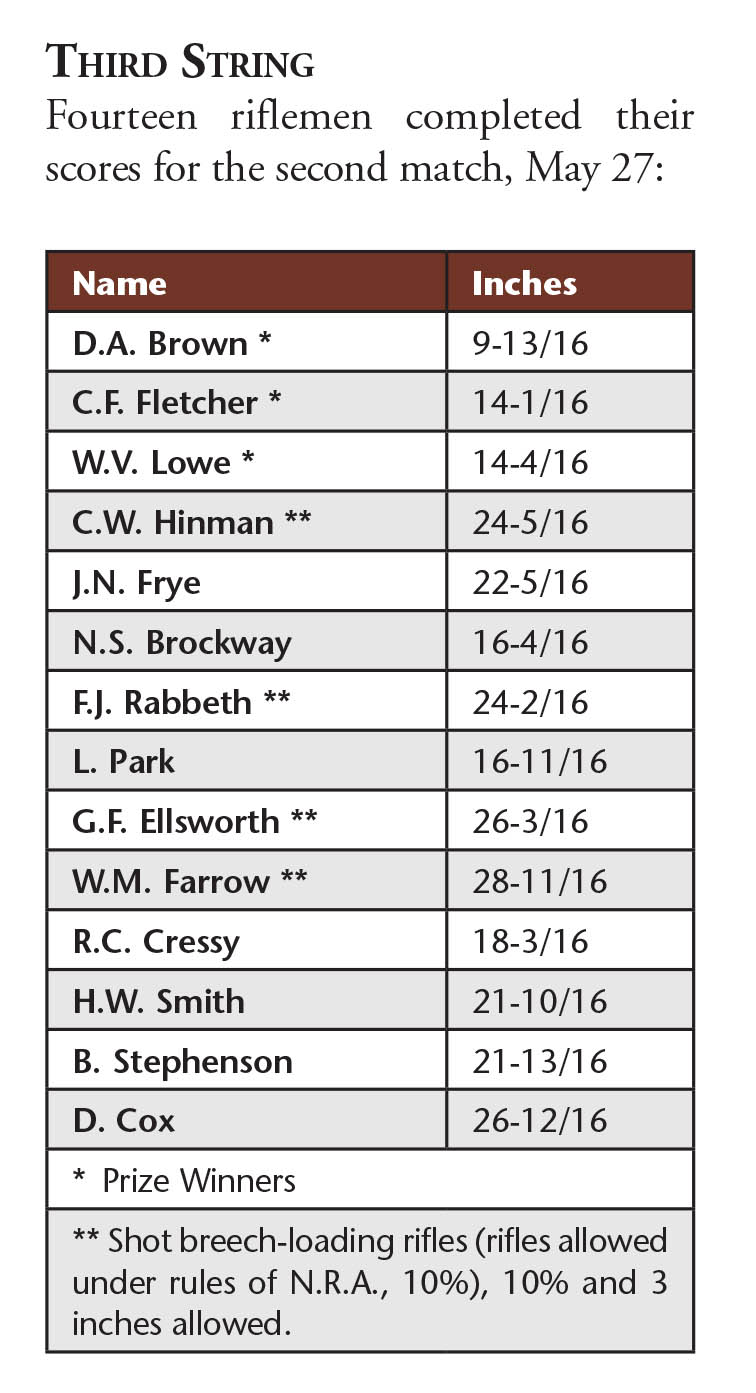
But it was the June 3, 1886, issue of Forest and Stream that provided the real detail of the match; the riflemen, their rifles, loads, and detailed information on the manner of loading that we, as riflemen, love to read about:
RIFLE AND TRAP SHOOTING
RANGE AND GALLERY
NATIONAL RIFLE CLUB
This particular spring meeting was to become an episode in the history of the club. Much correspondence had been indulged in with the Walnut Hill marksmen, and these capital shooters of the modern school had promised to come up Vermontward and try conclusion with their antediluvian prototypes. The old fellows were delighted with the prospect of a good lively set-to, for the spirit of the fight is strong within them, and there had been so much talk on the seemingly everlasting theme of Muzzle vs. Breechloader that everybody was charmed at the prospect of having the two classes of arms brought side by side, each in the hands of enthusiastic experts and each shooting under the same weather conditions. So, when the 12 o’clock train came up from the southward at yester noon, and out of it tumbled Hinman and Rabbeth, Frye, Ellsworth and Maynard, each with rifle and shooting traps, it was generally agreed that the spring meeting of 1886 was to be a big success. The chroniclers were there too, ready with pen and pencil to picture in work and line the doings of this novel rifle meet. Mr. Gould came down from Boston, that the Rifle might know all that occurred, and with convenient camera caught the various doing of the riflemen.
The newcomers were greeted in the kindliest spirit. There was the range 40 rods away from that little outhouse sort of a shooting box. Across yonder bit of low-lying water-covered meadow to the face of the low hill where a temporary fence of slab boards sufficed to hold the paper targets. Sticks here and there held all manner of streamers, for each marksman carried his own private wind signals, and stuck them up as his fancy dictated. Some used long whiplash streamers of silk, slightly weighted at the tip. Others again preferred the bag-like bits of muslin and these stood out like great bleached bolognas. One had contrived a wee wind signal, a model on a quarter inch scale of the big dial at Creedmoor. It was a picturesque range, but the main interest was at the firing point. Here was the house we have mentioned, about 20 ft. long; on the side facing the targets away to the westward, shutters lifted up, really opening the house side. They were low and one was compelled to stoop or sit down on the low stools if a view of the targets was desired. Pushed up against this opening ranged in line were the rests on which the muzzleloaders were placed. They were of the saw-horse pattern, securely fastened to stakes driven into the soil and so arranged that when placed upon them the gun muzzle would be about 2 ft. from the ground. Along the other side of the shooting house was the loading table, an ordinary workbench with notches along its front edge, and here the members do the manual work of the shooting, cleaning and swabbing, patching and loading, with all that care and deliberation which characterizes the typical muzzle-man.
Let us take our friends in order, beginning in that far away corner where a portly gentleman whose clear eye in a measure belie the slight tinge of gray in his hair. He is Mr. R.C. Cressy, of Brattleboro, Vt. His arm is of Brockway make, with an octagonal barrel, and comes just within the 15 lbs. standard 28-inch barrel. It has a caliber of .39, with an even twist of 1 turn in 16 inches, 8 grooves. The bullet is of Brockway make, forced out cold under a 40-ton pressure into long rods, then cut off in lengths and again swaged to shape. They have a uniform composition of 1 tin to 20 lead. The powder which Mr. Cressy uses is Hazard FFg. A bullet picked up from his box weighed 338½ grains, while a powder charge weighed 84½ grains. He uses a greased paper patch laid in two pieces across the gun muzzle. Like the majority of the other weapons, his arm is slightly choke bored, a point upon which some of the marksmen lay a great deal of stress. His method of attaching the weapon to the rest is very simple. The crosspiece attached to the barrel has in it a V-shaped notch, and this goes to a screw fastened in the rest top. In the rear, there are the usual thumbscrews, one below lifting the rear of the piece, and one on either side giving the brass notched piece in which the barrel rests a lateral motion.
Next to Mr. Cressy sits D.A. Brown, of Boston. He has a round barrel arm made by Warner, of Syracuse. It falls within the 15 lbs. standard, has a uniform twist of rifling with one turn in 20 inches, 8 grooves of .45-caliber. The barrel is 30 inches long and is slightly larger at the muzzle than the breech, the purpose of this disposition of weight of metal being to stiffen this outer end of the barrel and prevent in a measure the springing of the barrel. Mr. Brown uses a Warner made bullet with a hard point built up of a 1 to 1 antimony and tin composition, while the rear end of the bullet is of pure lead, the two parts are closely swaged together, and the taking of the rifling by the pure lead heel is the point aimed at in this composite missile. He uses powder of the Dead Shot brand, American Powder Company make. The bullet, weighed by your correspondent, as all the other powder and bullet weights in this report were taken, showed a weight of 671 grains, while a single powder charge showed 142½ grains. In loading, Mr. Brown uses a linen shellacked and then greased, two narrow strips laid crossways of the muzzle in order that the eight grooves might be taken uniformly. His shooting stand resembles exactly a miniature gun carriage. There are two long ways on either side on which the cross head forward rests and slides, while at the rear there are two side and bottom screws. Mr. Brown is deliberation and good nature itself. His every motion is ciphered down to a system, and it is almost amusing to see him pour the powder in and then with moistened rod at once look for it. Yet in this way he avoids that constant menace of the absent-minded muzzle marksman, a bullet in the barrel and no powder behind it.
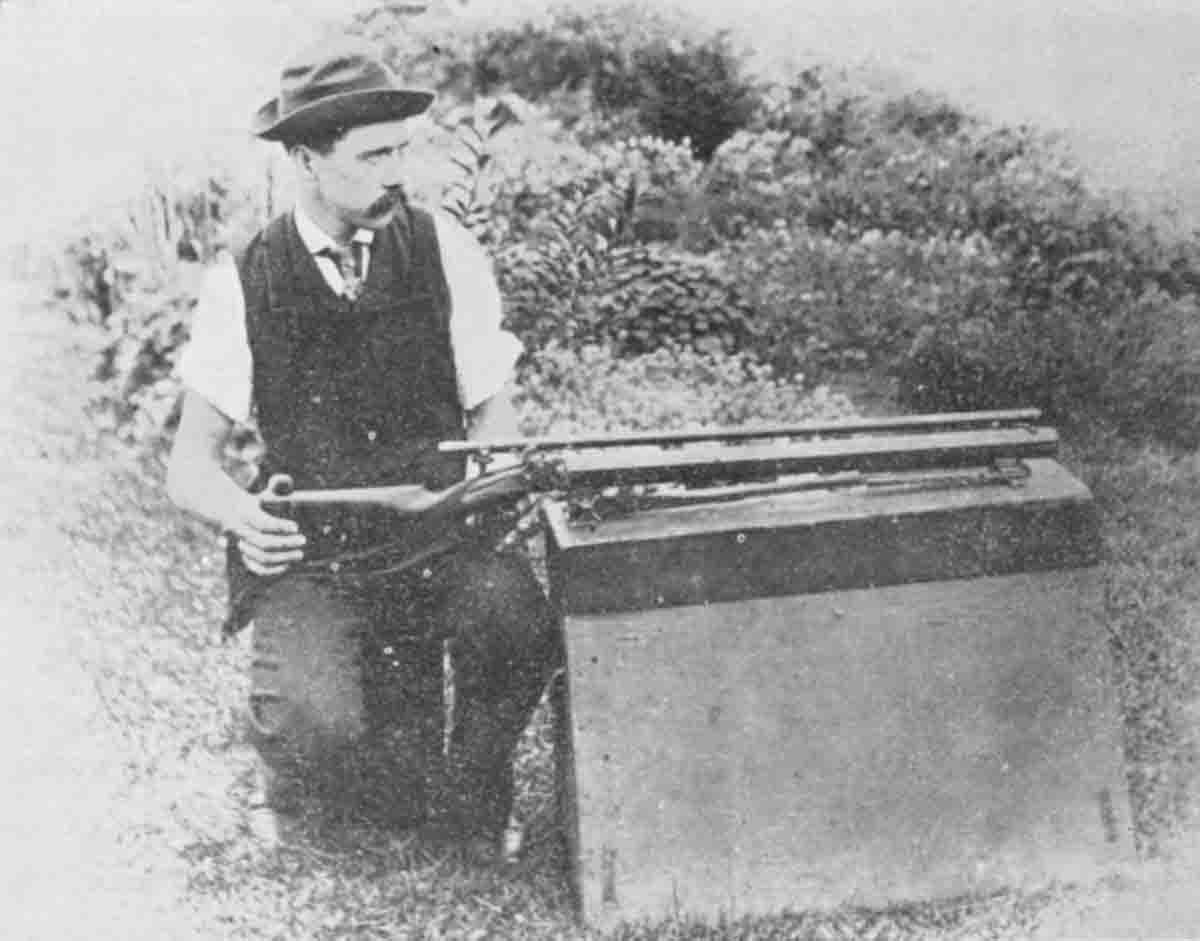
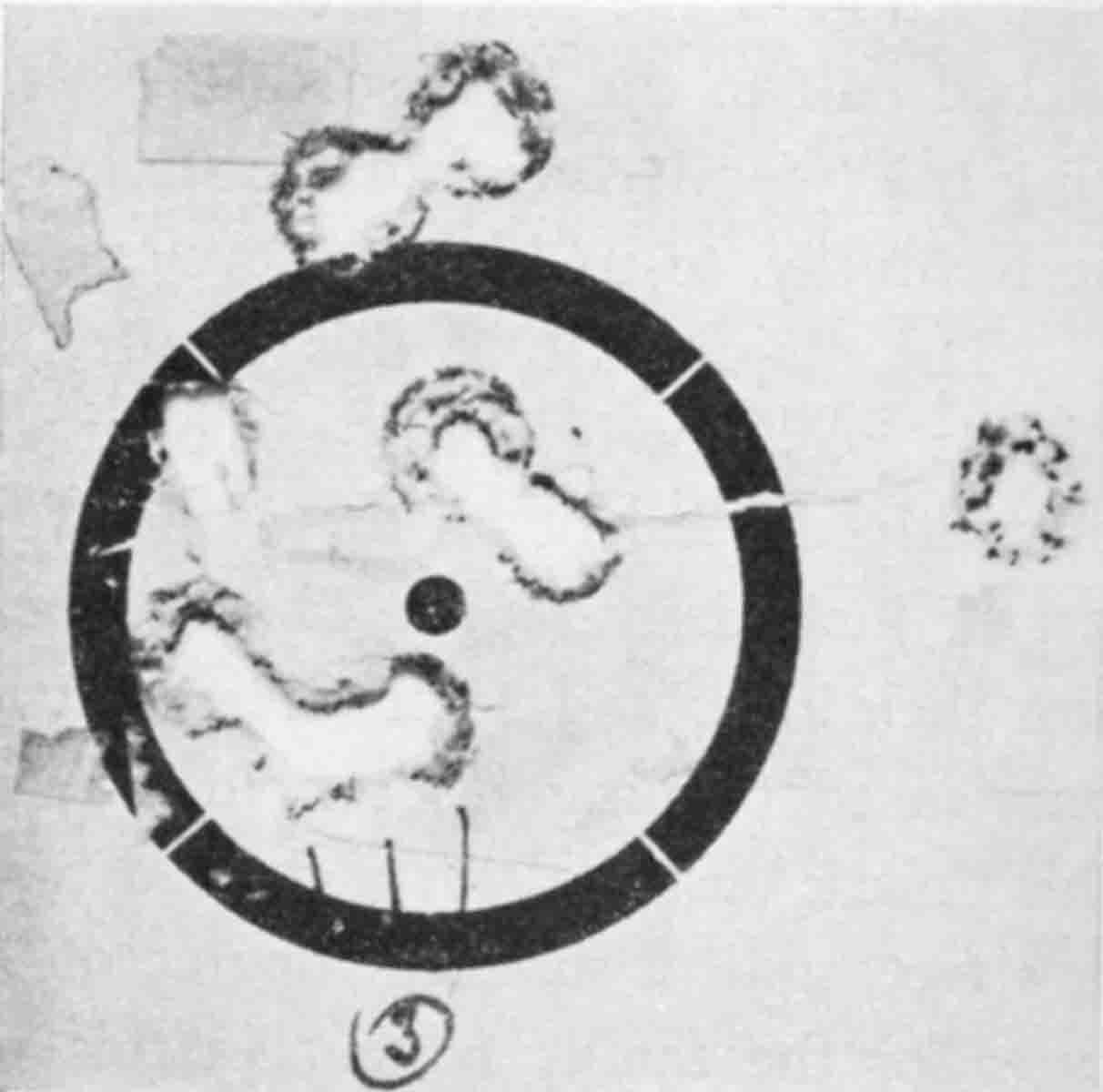
Mr. F. Fenn is one of the younger members of the club. He resides at Dover Plains, N.Y., but generally manages to get up and enjoy the shoots. He uses a gun made by Phillips, of New York, and in this meeting was in very bad luck, owing, he thought, to the use of some special cartridge he had made. These were of the composite type with a hard point made by putting 2 ounces of antimony in a pound of lead, while the bullet heels were of pure lead. The weapon was of .45-caliber, having 8 grooves of a gain twist rifling starting in at one turn in 72 inches and finishing with one turn in 24 inches. The barrel was 27 inches long, of octagonal form, and into it he poured Hazard’s FFg powder. One charge weighed showed 128 grains, while one of the bullets turned the scale at 572 grains. A stout wooden block held the gun while the
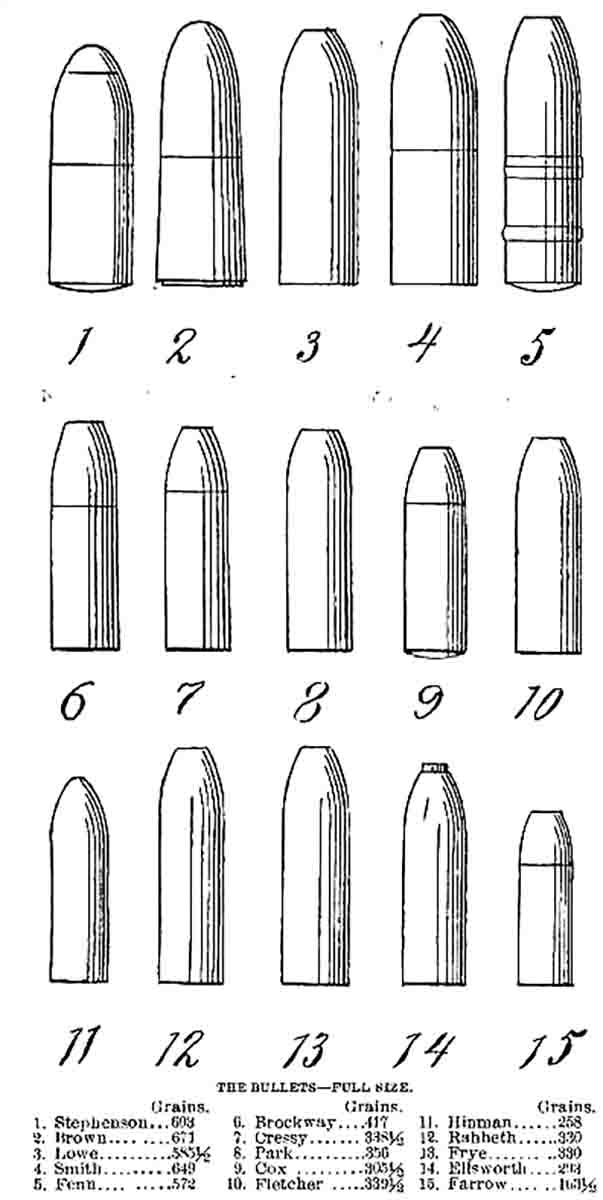
Mr. E.B. Stephenson followed along the line with his big muzzle-loader. It shook a small section of the State when it went off. It was a .50-caliber weapon with a 30 inch, 15 lbs. octagonal barrel made by Ferris. There were 9 grooves, necessitating in loading three paper patch slips. The rifling grooves were concentric with the bore of the barrel and had a gain twist increasing from 1 in 72 to 1 in 24 inch. The bullet is worthy of special attention. It was of the composite order, with a soft heel, a soft point and a hard-inner section, this gave that close grip on the rifling when the upsetting came which was particularly striven for in this make of bullet. A paper patch was used and Hazard’s FFg powder. The rest device was the simplest in the house. Two bent strips on either side forward preventing any jumping up of the muzzle, while aft the barrel rested on a broad tongue, the upturned edges of which afforded place for the screws used in side adjustment.
Veteran L.C. Smith was next in the line, a patriarch among patriarchs, he knows the history of the club since its formation. He was a charter member and has never missed a meeting. He is yet full of shoot and is always in some experiment to settle some point in the science of rifle shooting. The consequence is that as a prize winner his name does not appear as often as it otherwise would. His gun has a 28-inch octagon barrel. To name its maker would be difficult, since it has been cut and re-cut so frequently. It is of .46-caliber with a uniform twist of 1 in 18. The bullet is of similar make to that used by Mr. Brown, and comes from the works of Warner, at Syracuse. Behind it he puts Fg powder of Hazard make. A sample charge weighed 113 grains in powder and 649 grains in bullet. He uses a cut paper patch, made in the form of a Greek cross, so that the paper is not doubled below the heel of the bullet. His rest in shooting is a very complete one with a pair of guiding ways forward, while the shifting of the trigger end is done with great throttle valve wheels. This, as many of the other guns, has the double nipple. In place of using the ordinary percussion cap, a flat primer is placed over the nipple paper, and over it a false nipple with a striking pin is screwed. This pin when struck by the falling hammer starts the primer and the charge is ignited without any loss of powder or pitting from the touch-hole.
D.S. Cox, of Neperan, Weschester Co., N.Y., has a .38 caliber gun having a 28-inch octagonal barrel, with 8 grooves and a steady twist of 1 in 16. His bullet is 1 to 20 uniform composition, and the powder FFg. Hazard. The loss of one hand put him to some disadvantage but not to any material extent, and he is always ready on time for his shot in the string. He uses stout parchment paper patch cut very narrow. His rest has a narrow iron guiding way forward, while a brass resting block, near the breech, enable quick adjustment to be made, as the cross-hair lines of the telescope demand. A sample load showed 305½ grains of lead and 69 grains of powder.
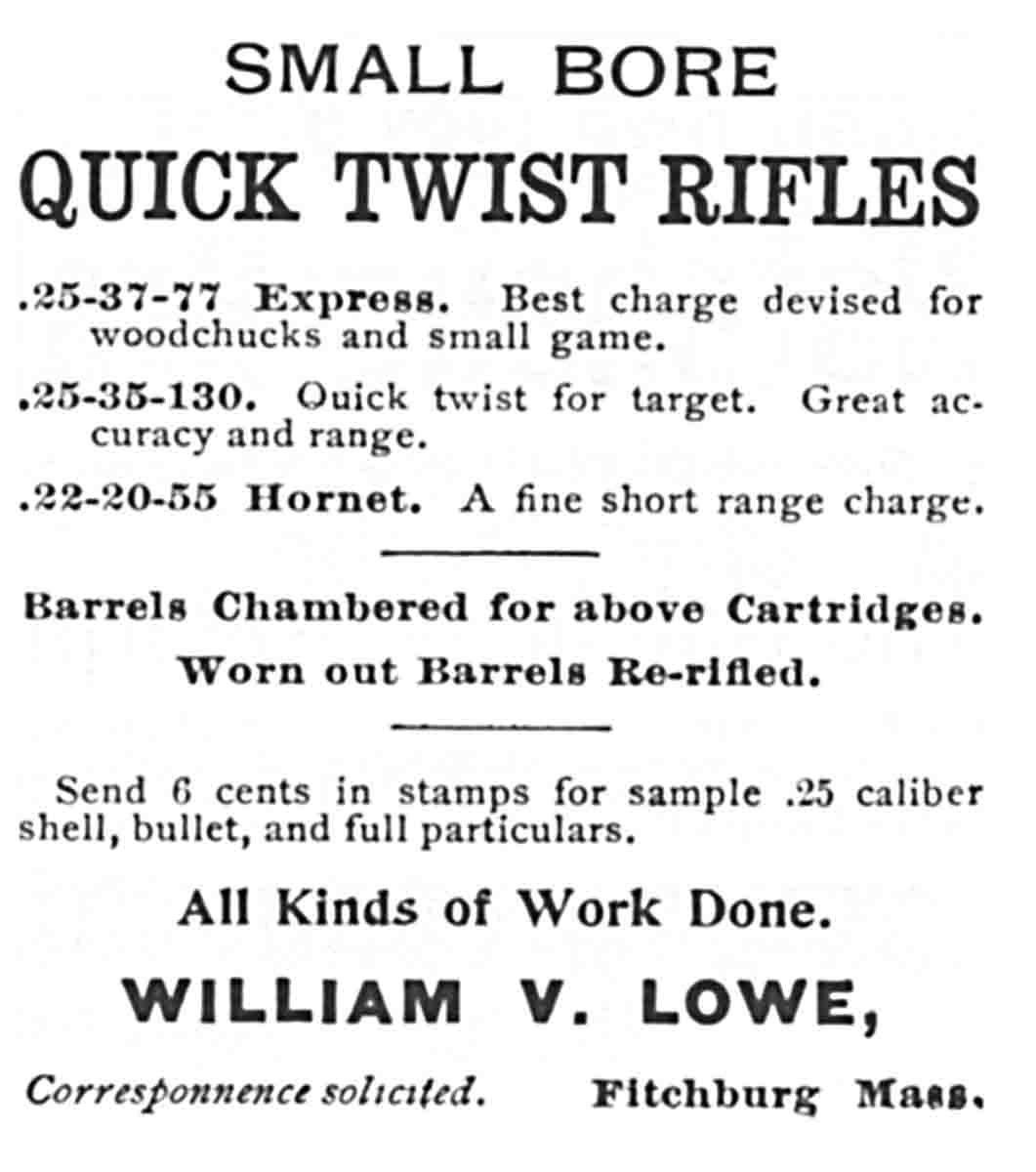
C.F. Fletcher, of Bellows Falls, Vt., is another of the young men in the ranks. He uses a Brockway-made gun and has a .38-caliber rifle with a 28-inch octagon barrel. There are six grooves of 1 in 16 twist, and the bullet is of the cold-pressed type and of 1 in 20 composition. The powder is of Hazard FFg make, a charge taken weighed 339½ grains of lead with 82½ grains of powder. He uses a paper cross patch, and in loading is most careful in every movement, being especially careful about the cleaning out of the rifle before inserting a fresh charge of powder. His rest is of a simple sort, a V notch forward and a block with three screws aft completing the fixtures.
William V. Lowe is a Fitchburg, Mass., citizen, and comes up to the match with what he styles a mongrel gun, that is several makers and remakers have tried to make it better and with varying success. It has a 28-inch octagon barrel, .45-caliber with a uniform twist of rifling 1 turn in 20 inches and 8 grooves. He uses a combination bullet lead butt and hard joint, and employs Fg Hazard powder, one charge taken and weighed showed 108 grains of powder to 585½ of lead. His patch is a thin parchment paper one cut in Greek cross fashion and with an abundance of grease. His rest had a double base, the upper one on which the rifle was placed being moveable at the rear and so admitting a vertical and lateral adjustment.
Outside of the shooting house the breechloader visitors from Boston were accommodated. A rest was improvised by driving two stakes in the ground, placing a crosshead and then a long plank with a notched block at the end enabled the Bostonians to sit comfortably on chairs and draw their rifles carefully and exactly.
Mr. Hinman used a .35 caliber Maynard and into this he put the patched bullet and the freshly loaded shell, charged with Laflin and Rand musket powder; a sample charge of powder weighed 61½ grains, while the bullet of 1 to 20 composition weighed 258 grains.
F.J. Rabbeth had a Remington-Hepburn rifle of .38 caliber. It had a round barrel and aperture front sight, as did the arms of his associates – Messrs. Hinman, Frye and Ellsworth. He had the regular 330 grain Remington patched bullet, as shown, of 1 to 20 composition. It was loaded with Laflin and Rand musket powder. A sample charge showed, powder 67½ grains; bullet 330 grains.
Mr. Frye used a Ballard .38-caliber rifle of the ordinary make. His patched bullets were the 330 grain Remington make and the powder, Hazard’s FFg, a sample charge weighing 55½ grains in powder and 330 grains in lead.
Mr. Ellsworth, jolly and fat, capital at off-hand work, as his Manchester score of the week preceding showed, not so good at the strange rests provided, was provided with a 30-inch long barrel Ballard of .38-caliber, loaded with a homemade bullet of 1 to 30 composition. The rifle was in all respects like that of Mr. Frye, with the full Rigby barrel. The powder used was Oriental Fg and a pattern charge showed 48 grains of powder to 293 grains of lead.
The plan of shooting is a very simple one: On the morning of the first day each man devotes his time to fixing up his shooting stand. There is a small trunk full of tools – oil bottle, rags, ammunition and knick-knacks of every kind – to be unpacked; then the gun itself and the telescope and the rest fixture, all are unpacked, and the various parts put in place. This is no small job. Each man takes a cardboard about a foot square, tacks it upon the low fence against which the shooting is done, and then the small black patch or “budd” is banged away at until the marksman has everything down fine. He watches the flags, makes due allowance for wind, finally determines just where the aiming budd is to be placed in order to get the shots aimed about the spot where the lines drawn from opposite angles of the piece of cardboard cross in the center. So, it may happen that each of a dozen men may be aiming at a dozen different points and all striving to get their shots bunched at the same point. When each man has got his piece in good working order there is a pause for luncheon, and then comes the counting string. It is shot on a time limit; that is, a timekeeper with watch in hand waits until all are loaded and then the call of “Time” is made. Five minutes’ elapse, and in that period of time the shot must be fired. Each rifle is in place, with hammer raised; “click,” and the hair triggers are set. Then in silence each waits for those flags to be a trifle less frisky; for that fishtail wind to swing about to the other side of the center before touching off. Each is, in fact, waiting for that precise wind which prevailed when he fired his last trial shot, the record of which he knew and was satisfied with. Often in a temporary lull the line of rifles will go off in a volley. While again, some unlucky one who waited for a better chance is compelled, when he hears the voice of the timer call out “Four and three-quarters,” to shoot in whatever wind may be blowing at the time. As the rifle recoils, the right hand is ready to check it; but from first to last there is no sighting beyond a glance through the telescope to see that the cross hairs have not been directed to another point.
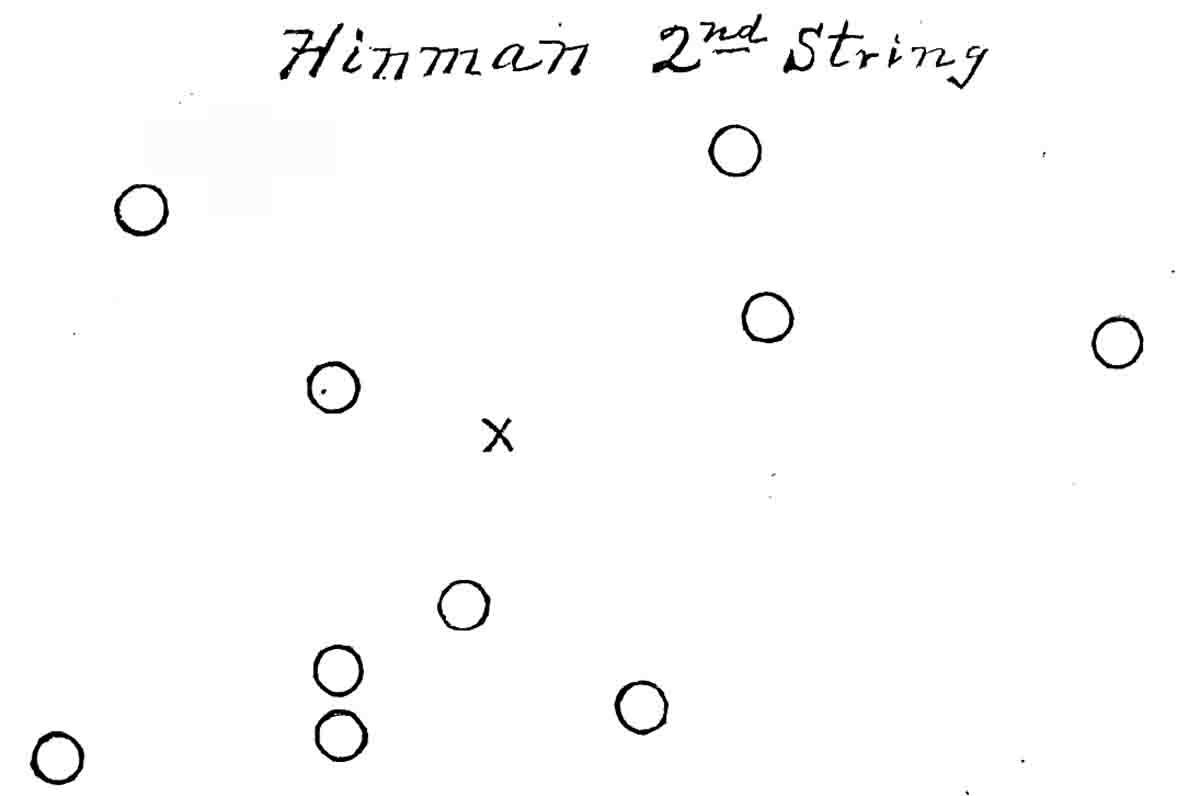
Meantime a lad has patched each bullet-hole with a narrow strip of paper, a second shot comes, it may cut the patch, if so there is no dispute as might very readily arise when such close shooting is done. So on through the series of the shots consuming an hour and a half perhaps, for each man, when time is called, looks and waits for the wind to suit him, and the loading is a matter not to be slurred over by any means.
The question of a proper allowance to be made for the smaller rifles was the first one considered after the Bostonians had unlimbered and prepared for work. “Make your own proposition and we will agree to it,” was the generous proffer of the home guard of muzzle shooters. So, the visitors thought that ten per cent for telescopic sights should be allowed, then an additional ten per cent for the fixed rest, and finally three inches off the string for the difference in the weight of weapons. Under these conditions of difference the men shot and the complete scores of the several strings will show how the handicap worked.
The first string was shot on the afternoon of the 26th. The weather was chilly, far past the point of comfort, while the wind flickering and shifting in fishtail fashion from about the 12 o’clock point, made the shooting very “onsartin” indeed. The breech men soon found out where the advantages of the rest system were, for where they with eye down to peep sight were unable to catch any fluctuation of the wind, and often pulled trigger just as the gust followed the lull, the muzzle shooters sat with eyes wide open watching the streamer, and when the right second came a slight pressure of the finger on the hair trigger and off the piece of ordnance went. It will be seen that the light guns held their own and Rabbeth, quick to catch the conditions of the difficult new range, had won a place among the three prize winners at the head of the column. Fletcher made a very creditable target indeed, especially under the conditions. The shooting over, there was a general pilgrimage to the targets, and as Secretary Brockway drew the tacks the probabilities of place were canvassed. On the back of each bit of pasteboard the shooter’s name was written, so that when the scorer having thrust a pin into the exact center and having attached the measuring rod, did not know the marksmen as he read off the shots in inches, eights and sixteenths.
An evening spent in rifle chat, in talk of trajectories and deflection, of initial velocity and windage and all the other topics of interest to marksmen, and all hands retired to an early couch to sleep sound till early morn, then up for a double string. The wind had moderated in a great measure, and again the marksmen were at it bright and early to get windage before the time was called on the first string. The breechmen had caught the bearing of things in better shape, worked together with more harmony, and the counting up found two of them leading the score. This was somewhat of a surprise to the host club men, but they were satisfied that the score had been made in direct rivalry, and were more than pleased with the fact that the breechloaders could do so well. The target of honor in this match belongs to Mr. Hinman. It is unfortunate that the antiquated style of marking does not admit of numbering the shot, but such as it is we present it, in full size, and remembering that it was shot at 220 yards, it is good work even from the sort of rest provided for the day.
With a sky threatening rain, there was no recess between the second and third strings of the meeting. The wind had died down some, and the strange rifle range sight was presented of men waiting for a bit more breeze to come up to waft them on the target. This was the position of those men who had sighted during the morning when the wind was fresher and could not afford to do any trial shooting in the midst of their string. There were at the finish of this string fewer men who carried off their targets rather than have their scores go upon the record. None of the breech men appear in the place of the winners, though Mr. Frye just falls without it. Mr. Farrow, who had not the 10 per cent for fixed rest deducted from his string, was not in good luck. He was busy at his perpetual experimenting, and was not in the best of form. The big Warner gun of Mr. Brown came to the front in good style, and a string of less than 10 inches was deserving of special credit when the rather tricky wind is considered. In addition to the 50, 30 and 20 per cent division to first, second and third in each string there was a silver medal presented by Mr. L.C. Smith for the best aggregate string of the meeting. This went to Mr. Brown on a total of 355⁄8 inches for the 30 shots. Very close, even with the arm used.
The meeting, on the whole, had been a capital success; so thought the old National Rifle club, for though it is old in years it is full of the true youthful sportsman’s feeling; so thought the visitors, for they had been most kindly treated and carried away with them only the most pleasant recollections of the quiet little Vermont village just over the Massachusetts line….6
In regards to the term “string measure,” Ned Roberts mentioned there were at least three versions of “string measure” in use since the pioneer days.
The First: It was customary in the early shooting matches for each man to provide his own “mark,” “board,” or target. This was usually a charred piece of board – charred by burning as that makes an especially black color – about a foot square, with a piece of white paper in the center having a cross marked in the middle of it.
After the required number of shots had been fired, it was brought to the firing point, a wooden plug was placed in each bullet hole, a piece of string was held by one end at the center of the cross mark, the string carried around the wooden plugs in the bullet holes, back to the center spot and cutoff. This string was then measured and the man whose string measured the shortest was the winner.
The Second: At a later period the earlier method was changed and thereafter they measured with a piece of string from the center of the cross mark to the center of each half of a round ball which each man provided and which was placed in each bullet hole of his board. The string was measured, the length set down on a piece of paper, the distance of the center of each half bullet from the center of the cross was measured in the same way and set down; then by adding these measurements the total length of the string was ascertained and the man having the shortest total was the winner.
The Third: After approximately 1840, the third version of “string measure” came into common use. After a shooter had fired the required number of shots on his target, the target is brought to the firing point where an official “Measurer of Targets” places the target over a piece of paper, pricks a hole with a small “scriber” through the center of the “bud,” or center spot, and in the same way marks the center of each bullet hole. Then a pair of dividers are used in measuring the distance from the center of the “bud” to the center of each bullet hole, these distances are recorded in inches, eighths and sixteenths. These measurements are added and the total is the “string measurement” of the group of shots. This is the most accurate method of measuring, or scoring, groups shot with any caliber of rifle, but is too slow in operation to permit using it in matches where there are many contestants who each fire five shots or more, and is only occasionally used by the men who shoot muzzle-loading rifles today.7
What I found especially interesting was that the specifications of each rifle used by each competitor were detailed. These same rifles are, for the most part, visible in the photograph taken by A.C. Gould on May 27, 1886. I was also disappointed that Myron F. Roberts, apparently, was one of the breechloading riflemen that chose to be a spectator instead of a competitor. C
References:
1. “The National Rifle Club,” The Rifle, Volume 2, No. 1, Boston, Mass., May 1886, Page 153
2. “National Rifle Club,” Forest and Stream, Volume XXVI, No. 12, Forest and Stream Publishing Company, Nos. 39 & 40 Park Row, New York, April 15, 1886, Page 230
3. “Range and Gallery,” Forest and Stream, Volume XXVI, No. 15, Forest and Stream Publishing Company, Nos. 39 & 40 Park Row, New York, May 6, 1886, Page 292
4. The Muzzle-Loading Cap Lock Rifle, Roberts, Ned H., Stackpole Books, Harrisburg, Pa., Page 120
5. “The National Rifle Club Meeting,” The Rifle, Volume 2, No. 2, Boston, Mass., June 1886, Page 170
6. “Rifle and Trap Shooting,” Forest and Stream, Volume XXVI, No. 95, Forest and Stream Publishing Company, Nos. 39 & 40 Park Row, New York, June 3, 1886, PP 374-376
7. The Muzzle-Loading Cap Lock Rifle, Roberts, Ned H., Stackpole Books, Harrisburg, Pa., Page 123
.jpg)
.jpg)


